From curing sausages to brewing beer: Here’s 10 potential uses of human waste
>
Scientists put people off their lunches last week when they revealed they’d been able to grow cabbages in human faeces that are safe to eat.
According to the German experts, human poo could be used as a cheap fertiliser for crops – and could soon give Sunday’s roast dinner a twist.
Although initially a revolting idea, plenty of research is suggesting there are several ingenious uses for our pee and poo that are better than flushing it down the toilet.
Here, MailOnline looks at 10 weird and downright disgusting examples, from brickmaking, making sausages and storing it in banks for ‘poo transplants’.
MailOnline looks at 10 weird and disgusting future uses of human waste, from brickmaking, charging electronics and storing poo in banks for transplants
GROWING VEGETABLES
Last week, scientists at University of Hohenheim reported that white cabbages grown in human faeces are safe to eat.
The experts used faecal compost recycled from dry toilets to grow the successful yields, although they said ‘consequences of long-term application of fecal compost requires further investigation’.
They also had success with nitrified urine fertilisers’ (NUFs) – modern products synthetised from human urine collected separately from faeces.
The research could mean we soon have a plentiful and inexhaustible supply of fertiliser to grow cabbages and other vegetables in.
Composting poo rather than flushing it would also bring down water use and negate the need for synthetic fertilisers, which can harm the environment with higher nitrogen and phosphorus levels.
‘Using locally available resources such as human excreta to produce bio-based recycling fertilisers can substitute mineral fertilisers and thereby promote environmentally friendly food production,’ they reported.
The experiments recalled the the 2015 blockbuster film The Martian, where Matt Damon plays a stranded astronaut that manages to survive on Mars after using his own faeces to grow potatoes.
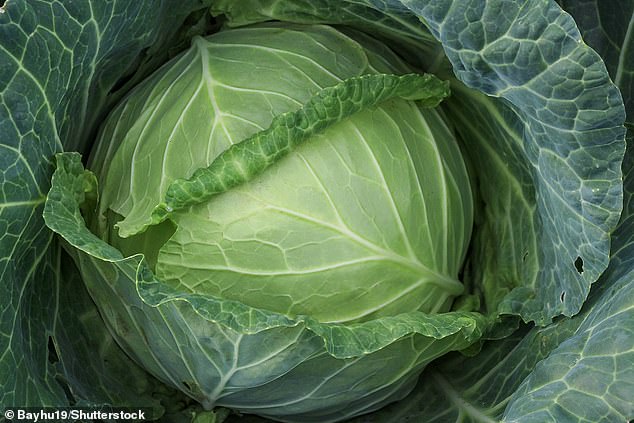
University of Hohenheim researchers found white cabbages grown in human waste were safe to eat (file photo)
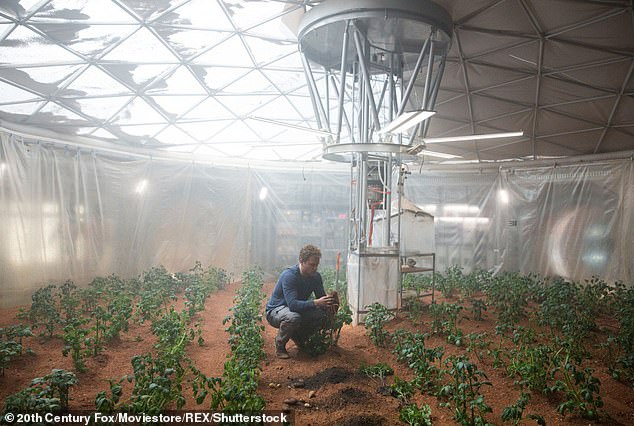
In the 2015 blockbuster film The Martian, Matt Damon manages to survive on Mars after using his own faeces as fertiliser to grow potatoes (pictured)
REFRESHING GLASS OF ‘PISNER’?
A Copenhagen brewery has been using urine collected at a music festival to help make its beer, in a project branded ‘beercycling’.
Nørrebro Bryghus, which has won awards at the prestigious World Beer Cup, has a beer called ‘Pisner’ that uses urine as fertiliser during the brewing process.
The brewery collected more than 10,000 gallons of urine from Denmark’s Roskilde Music Festival in 2015, which was used to fertilise barley fields.
Thankfully the beer itself did not contain pee, and one Danish reviewer said it ‘didn’t take like p*ss, not at all.’
After successfully demonstrating the use of urine to grow the grain, the method could take off among other breweries around the world.
Karen Hækkerup, CEO of the Danish Agriculture and Food Council, said: ‘Just as we have seen shops sell goods that would otherwise have been thrown out, beercycling allows us to recycle a product that is normally flushed down the drain.
‘When it comes to circular economy, Danish farmers are some of the best in the world.
‘If you can brew a beer with urine as fertiliser, you can recycle almost anything.’
Another brewery in Singapore has been making a beer called Newbrew that uses water recycled from sewage and urine.
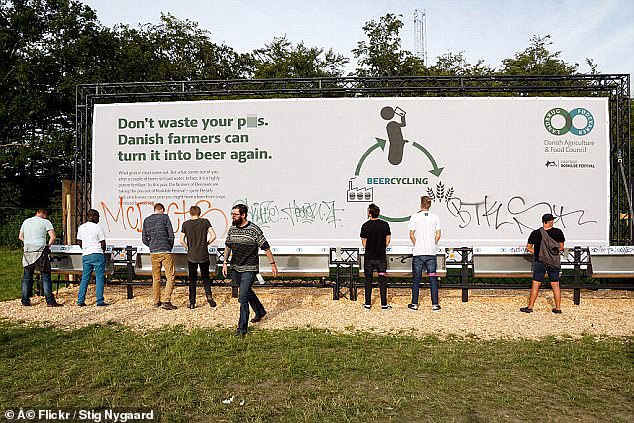
Danish brewery Nørrebro Bryghus collected more than 10,000 gallons of urine from Denmark’s Roskilde Music Festival in 2015, which was used to fertilise barley fields
PLANT FERTILISER
Researchers in Australia are planning to use human wee deposited in toilets at public parks to fertilise plants and lawns.
Urine separation technology under the U-bend would trap the good nutrients from urine for reuse, while simultaneously removing unwanted chemicals like heavy metals.
Urine contains key macronutrients – potassium, phosphorus and nitrogen – needed for plant growth and is therefore an excellent fertiliser.
The government-backed trial is testing different toilet designs in parks in Sydney and Brisbane, although authorities are gauging the public’s response to the scheme first.
Chief investigator, Professor Cara Beal at Griffith University in Queensland, called human urine ‘a treasure trove of liquid gold nutrients’ such as nitrogen, phosphorous and potassium.
Designs for the technology, as well as locations for the loos, are currently being considered.
But one proposed system would use an anode and a cathode (two of the main components of batteries) to separate chemicals in urine, using elements in the surrounding air as a catalyst.
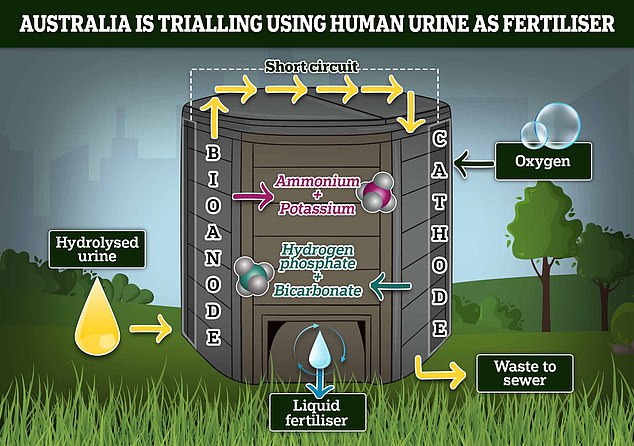
Australia is planning to trial the use of human urine as fertiliser for plants and lawns in public city parks, as part of a four-year, government-backed project. Pictured, a potential toilet design for the project, using an anode and a cathode to separate chemicals in urine, using elements in the surrounding air as a catalyst
CURING SUSAGES
Nothing will put you off your food quite as well as the poo from a baby, yet scientists in Spain have said it could be used to ferment fatty, chorizo-style sausages.
In a 2014 paper, they identified Lactobacillus rhamnosus, a probiotic bacteria, as effective for the manufacture of ‘fuets’ (dry-cured pork sausages).
Bacterial samples were isolated from infant faeces from the nappies of 43 babies aged up to six months old.
The team of researchers, who published findings in the journal Meat Science, said their creations tasted ‘very good’ and as a traditional fuet would.
They reported: ‘Final products recorded a satisfactory overall sensory quality without any noticeable off-flavour, and with the characteristic sensory properties of low-acid fermented sausages.’
POO TRANSPLANT BANKS
In the US, scientists are aiming to create a bank of stool samples to help with faecal transplants, which are performed to treat infections with a bacteria called Clostridium difficile.
Faecal microbiota transplantation (FMT) – the transfer of stool from a healthy donor into the gastrointestinal tract of a patient – is already being performed.
However, experts in Massachusetts outlined their vision for ‘stool banking’ so that people are being transplanted with their own poo rather than someone else’s.
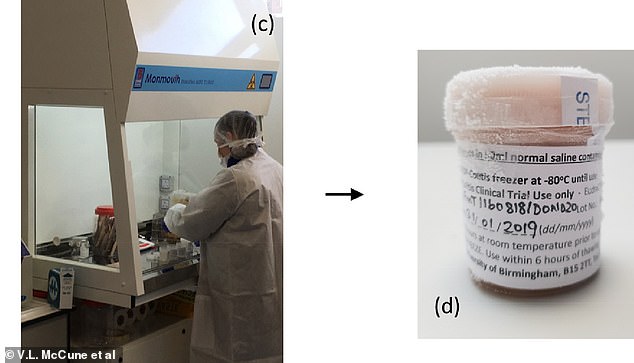
Researchers have tested the feasibility of ‘stool banks’ using faecal microbiota transplant for the treatment of Clostridioides difficile infection
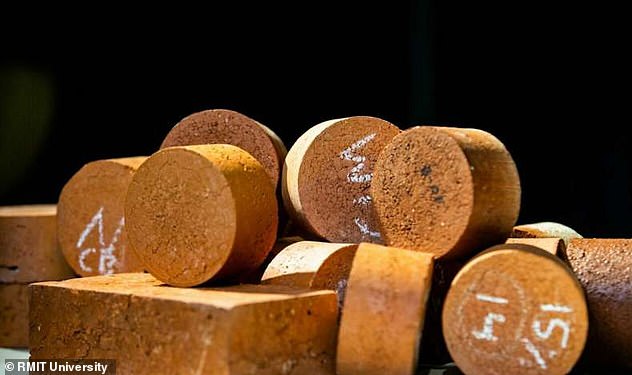
A novel method combined clay with faeces and bricks made with up to 25 per cent human waste passed stringent strength tests (pictured)
They suggest storing people’s stool samples when they are young and healthy and using them for FMT when they get the infection.
However, banking one’s poo would likely only be done by those who can afford the storage fees, according to the experts.
BRICKMAKING
In 2019, researchers unveiled a novel method for making bricks, by combining the traditional clay with the somewhat less traditional human poo.
Clay bricks made with up to 25 per cent human sewage still passed stringent strength tests, said the experts, from RMIT University in Melbourne, Australia.
Additionally, the water absorption of the bricks was found to comply with the requirement for normal building bricks.
Using poo in this way could make use of the millions of tonnes of leftover biosolids that are stockpiled every year globally, they added.
What’s more, recycling biosolids in fired-clay bricks would ‘significantly reduce the carbon footprint of brick production’.
PRESERVING SPECIES
Everyone’s poo contains a vast community of microorganisms known as our ‘microbiota’, some beneficial and others potentially harmful.
Adrian Egli at the University of Zurich is working on Microbiota Vault, a bank of frozen stool samples from people around the world.
He wants to preserve some of the more overlooked endangered organisms on Earth – those living in humans guts – by freezing them and thawing them if they go extinct.
Microbes inside us play a key role in breaking down food, helping us absorb essential nutrients, and can also can replenish the lining of our gut and skin, fix damaged cells and replace dead cells with new ones.
Along with international colleagues, Egli has collected about 3,000 stool samples so far, with the majority originated in westernised Switzerland.
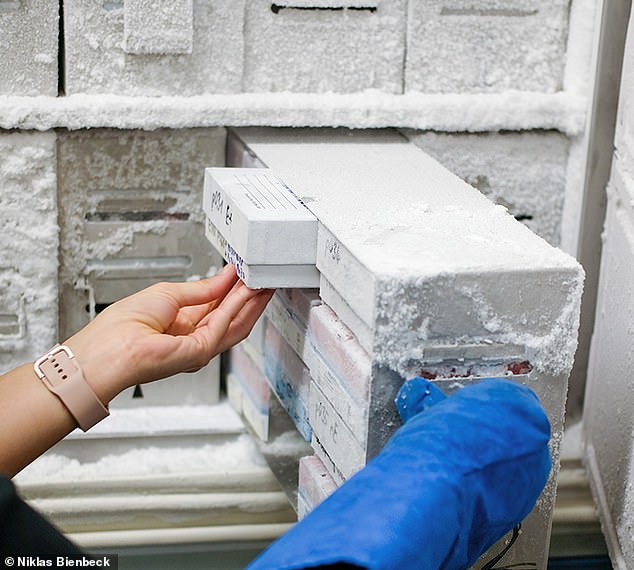
The frozen stool samples have been sent from all over the world to Adrian Egli’s lab at the University of Zurich
However, he wants to include samples from people with different lifestyles to expand the microbial diversity of his collection, including rural ones.
The project was inspired by the Svalbard Global Seed Vault, which stores ‘spare copies’ of valuable plant seeds in the event that the originals are lost.
POWERING ELECTRONICS
In 2016, researchers at University of Bath announced they’d developed a small ‘microbial fuel cell’ that can generate electricity from urine.
A microbial fuel cell is a device that uses natural biological processes of bacteria to turn organic matter, such as urine, into electricity.
Electricity is generated by the bacteria which can then be stored or used to directly power electrical devices.
Researchers said their fuel cells are efficient and relatively cheap to run, and produce nearly zero waste compared to other methods of electricity generation.
Similarly, University of Bristol scientists have demonstrated that they can change a phone by using urine fed into microbial fuel cells.
Another potential use of microbial fuel cells is providing lighting for toilet cubicles in developed countries or disaster zones.
MINING PRECIOUS METALS
According to scientists at US Geological Survey, human poo contains valuable precious metals that are being flushed down the drain.
As well as gold, faeces contains platinum, silver and other metals along with rare elements such as palladium and vanadium.

Dr Mirella Di Lorenzo at the University of Bath holds the small ‘microbial fuel cell’ that can generate electricity from urine
Meanwhile, ‘technologically important’ metals such as vanadium and copper could be used to make cell phones, computers and more.
The scientists want to ‘mine’ sewage, reducing the need to mine raw metals from the ground while reducing pollution by recycling human waste.
Research has estimated the waste from one million people could contain as much as $12 million (£8.7 million) worth of metals.
OBESITY PILLS
A poo pill could help obese people lose weight, although the New Zealand experts behind the idea have promised it’s odourless.
The pill contains bacteria from a healthy person of a normal weight but is given to someone else who is overweight or obese.
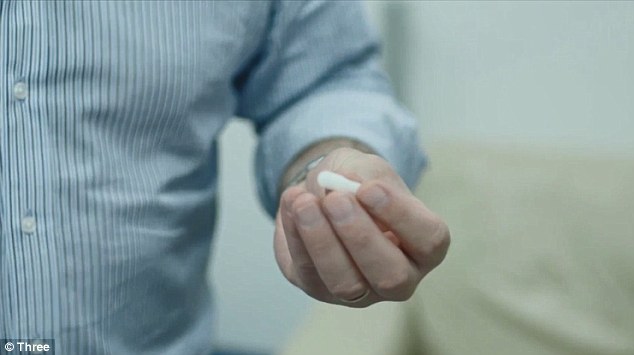
A New Zealand research company believes the key to solving obesity is a pill (pictured) containing faeces
The idea is that faecal bacteria from the healthy person will lodge itself in the gut of the overweight person, ‘scavenge’ calories from their waste and help them lose weight.
It’s estimated that about 30 per cent of our poo is made up of dead bacteria – about the same amount as indigestible food matter.
Bacteria used to make the pills have been strained and sieved to get rid of the unsanitary waste before they’re put in the capsules.
In a trial conducted by scientists at the University of Auckland’s Liggins Institute, obese teenagers were given a single course of capsules over two days.
Results showed it caused reductions in tummy fat, especially for women, and reduced a condition called ‘metabolic syndrome’ that can lead to heart attack, stroke or type-2 diabetes.
